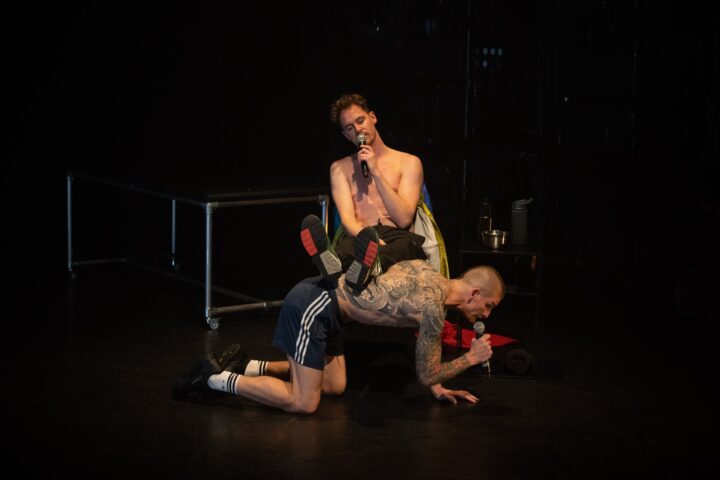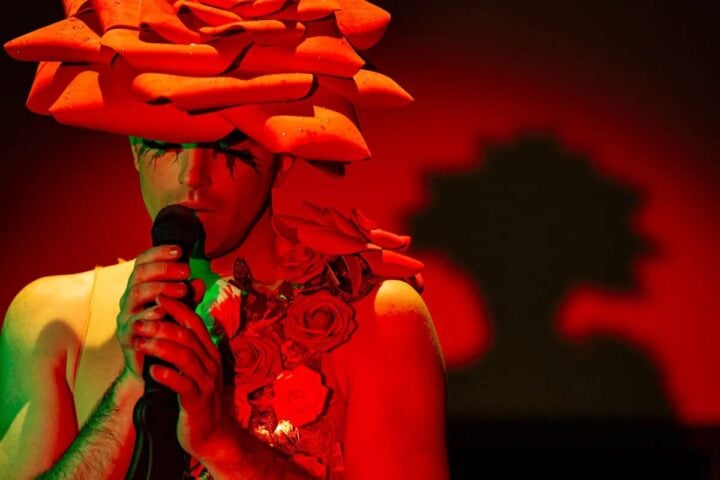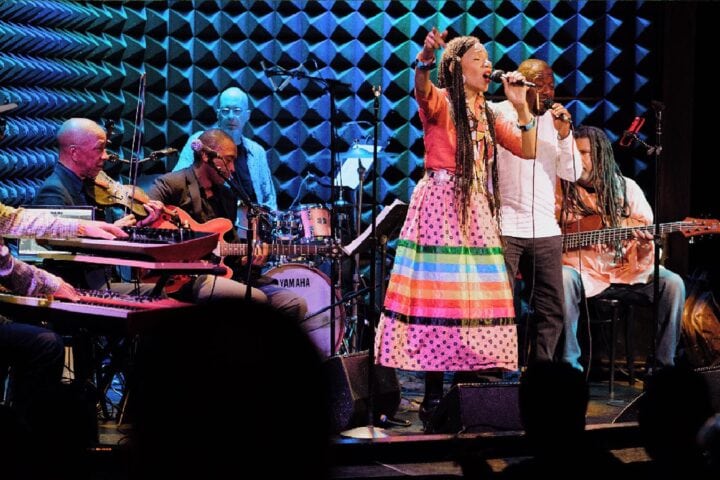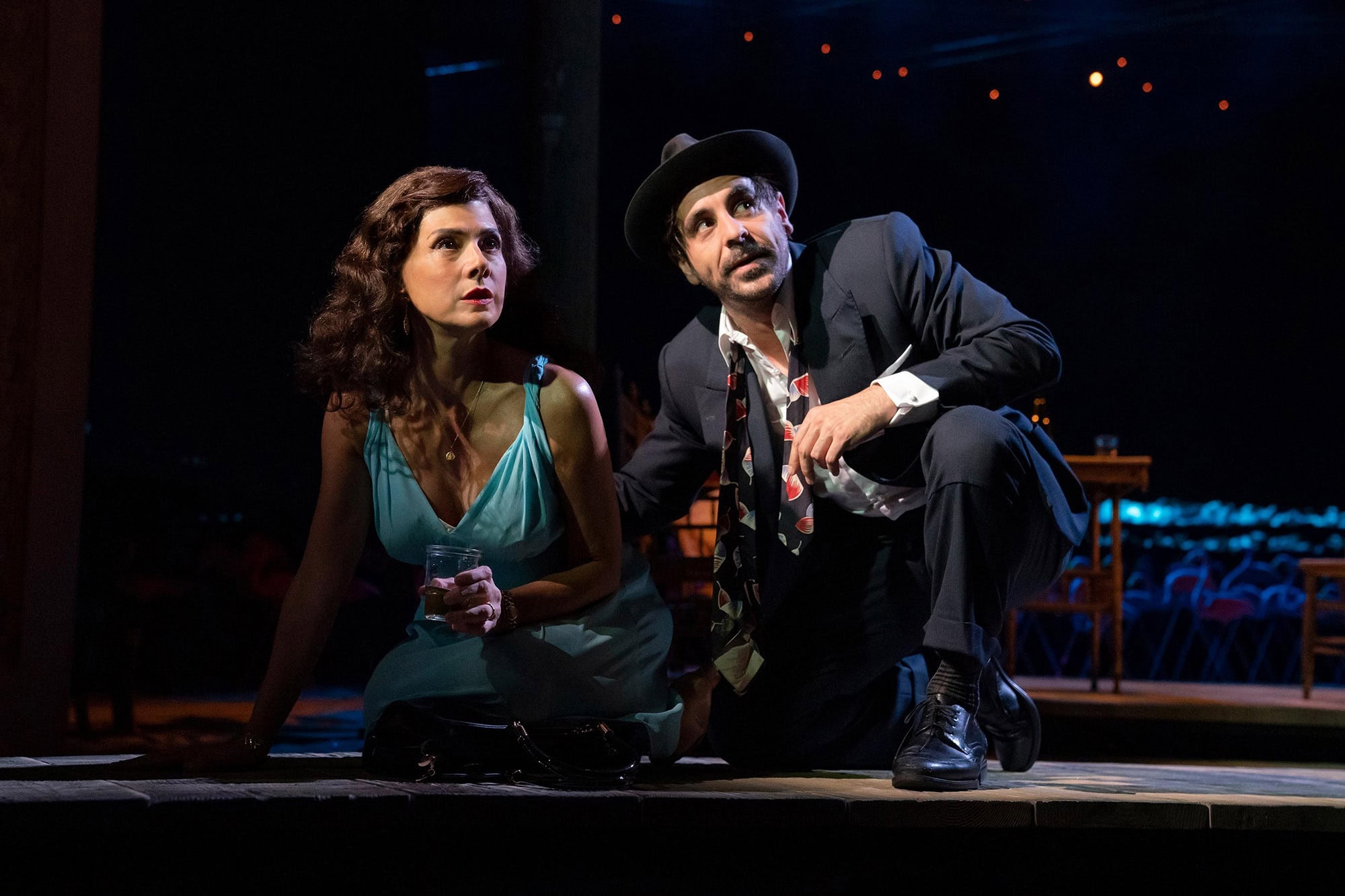Most of the plays I see in New York City are created by able-bodied, Anglophone playwrights. (More often than not they’re men, and more often than not they’re white.) For most New York theater critics, most of the time, “international” means “imported from London.” If it doesn’t, it probably means “directed by Ivo van Hove.” But at the Under the Radar Festival, the Public Theater’s 16-year-old annual international theatrical extravaganza, the thoughtfully curated program of new works blasts apart the predictable comfort of knowing what you’re getting yourself into.
Despite the relentless pace, marathoning in a festival setting like Under the Radar works against the critical impulse to get in and get out. Lingering in playing spaces beyond the curtain call to soak in the experience and seeking threads of connections between plays before cementing my verdict on any are rarer opportunities than I’d realized.
Experiencing the Under the Radar Festival—especially taking in shows at high quantity in quick succession—replaces the usual sense of familiarity with a sense of wonder. I haven’t adored every offering at this year’s festival, but, in each theater space, I’ve been keenly, refreshingly alert to my presence and my perspective as an audience member, to the ways in which I hear and watch and engage. I’ve looked sideways as well as dead ahead, and over the weekend, I saw two performances that required lengthy, committed conversations with the strangers sitting next to me. (And that’s especially valuable for critics, who sometimes need the reminder that other people’s opinions coexist alongside ours.)
This year’s lineup of plays has been particularly successful in making audiences acutely aware of themselves as a whole, as people who lug assumptions and anxieties and uncertainties into their seats. Take The Shadow Whose Prey the Hunter Becomes, the first play I saw this season and the festival’s most rewarding in its complexity. Throughout its hour-long run time, I had occasionally taken note of a long strip of yellow tape at the front of the playing space. During the play, the four actors, all of whom are neurodivergent and play characters who are neurodivergent, frequently step up to that line to speak to the audience. I imagined the line as a necessary, neon beacon for the performers to find their way forward.

Yet, in the final moments of the play, actor Simon Laherty (who also co-wrote the script with his castmates and other members of the Back to Back Theatre, an Australian company), tears the tape off the floor and exits. The gesture reads as a direct rebuke to the very ideas I’d been holding for the play’s duration: It seems to ask, ”Who are you to assume that the world of this play was built for its performers instead of for the characters they play? How can you, sitting there, decide what we, putting on a show for you up here, need in order to perform?” And I wondered, not for the first time: How did they read my mind?
Directed by Back to Back’s artistic director, Bruce Gladwin, The Shadow Whose Prey the Hunter Becomes stars four performers with disabilities playing characters (with their own first names) who host a sort of town hall meeting to educate the people in attendance about what it’s like to have a disability. The shared names between characters and actors are a red herring. These actors have disabilities, yes, but that doesn’t mean the characters with disabilities they play are them, any more than neurotypical roles match the neurotypical actors playing them. Again and again, through moves so subtle I’m not sure I didn’t imagine them, The Shadow Whose Prey the Hunter Becomes sets graceful, invisible traps for the audience’s assumptions about the capabilities of the performers and the distance between performer and character. And while I’m not entirely sure of the title’s meaning, it might have something to do with the play’s constant shadowy evasion of comforting resolutions: Never once is an audience member allowed to feel like they have mastered the art of empathy.
An early sequence seems deliberate in putting an audience on edge, as the long stretches of silence as actor Sarah Mainwaring prepares to speak made me wonder whether it was the actor or the character who had forgotten her lines. Was this discomforting silence performed or real? It’s part of the play, of course, just like most of neurotypical theater’s long pauses. But I feel sure that The Shadow Whose Prey the Hunter Becomes anticipated my discomfort and my doubt. That dark cocktail of emotions following the clarifying moments—relieved admiration for the performers, guilt for the assumptions I had made, embarrassment that I had been caught feeling uneasy—stayed with me for the rest of the play’s rich hour.
In that regard, The Shadow Whose Prey the Hunter Becomes is very much about the audience, and there’s nimble, layered playfulness as the characters obsess around whether the imagined audience at the town hall meeting are understanding their message. And while some of the sections of the text work better than others (I’m not sure about the suggestion that everyone will be deemed disabled when artificial intelligence overtakes human thought), the actors also engage brilliantly with the supertitles, which are supposedly transcribed live at the meeting by Siri. Supertitles seem at first like a tool for us, the audience, to understand the performers’ speech. As Scott Price laments, “I have autism, and, unfortunately for me, I also have a thick Australian accent.” But the projected text also doubles as a symbol for the dehumanization of people on the spectrum. “You can tell we have disabilities as everything we say comes upon a screen,” Sarah notes with disdain. “The subtitling is offensive.”
This point of view leads to a heated argument about language and representation, with Scott claiming the label of disability: “I’m a disabled person here and I’m proud and I don’t want to weave my way around language.” But there’s no unified front in how these four characters perceive themselves and seek to be perceived.
Perhaps the play’s sharpest touch is that Michael and Scott talk down to Simon, describing him as “very childlike” and insinuating that he can’t understand what’s going on or fully participate in the meeting. Sarah calls them out on this (“You’re talking like Simon’s not even in the room”), and it’s not just an indictment of how individuals with disabilities can be dehumanized to their faces but also an illuminating glance into how internalized measures of normalcy have permeated the disability community. This quartet of characters doesn’t include heroes or victims or saints and the play relishes in catching the audience in the act of attaching such labels to the performers. It’s a play I want to see again in order to try again, to use what I’ve learned from my first encounter with Back to Back to do better the next time.
If The Shadow Whose Prey the Hunter Becomes invites us to project imagined limitations on to the performers and then to watch those assumptions crumble, the creator of Samuel Beckett’s Not I at BRIC (the Brooklyn venue hosting this show) wants us to know exactly what to expect from the beginning. Yes, this is a performance—and an exhilarating one—of Beckett’s 15-minute, stream-of-consciousness monologue, first performed in 1972, but this production positions the piece at the center of a conversation with the performer, Jess Thom.
Thom, who’s best known in the U.K. for Touretteshero, an alter ego aimed at educating and spreading awareness of Tourette’s syndrome, has a number of repeating verbal tics that spark from her speech: Among the most frequent are “biscuit,” “sausage,” and “I love cats,” plus a few words and phrases that aren’t quite so “cute,” as Thom describes them. Unlike The Shadow Whose Prey the Hunter Becomes, the sense of unpredictability here is shared by the performers. A few times throughout the day, Thom explains, she will lose control over her body and speech, and this possibility creates a space of “genuine jeopardy.”
Such pre-show disclaimers are neither warnings nor apologies but a crucial aspect of Thom’s central work here: envisioning a truly inclusive performance space and then co-creating that space with her audience. There are no surprises in Not I. Thom explains, in detail, that her wheelchair will be lifted eight feet into the air atop a hydraulic lift; that only her mouth will be lit (as in all productions of Beckett’s monologue); that an ASL interpreter (the warmly expressive Lindsey D. Snyder) will sign every word of Beckett’s explosively high-velocity text, plus each unexpected tic along the way; that the post-performance experiences will include watching a video, discussing the monologue with a stranger, and participating in a Q&A.
The audience sits on padded benches and pillows on the floor, and Thom invites people to move and make noise during the piece as needed. An online guide to the performance even includes a sound map, alerting audience members to patches of loud noise, like applause and a section of the monologue featuring terrifying screams. With its shrieks and terrorizing, relentless intensity, Not I certainly defies expectations for the sorts of theater pieces that tend to offer relaxed, inclusive performances. But by reclaiming the character of Mouth through the lens of disability, Thom has made the jumbled thoughts of the character suddenly specific and, if not quite understandable, accessible through empathy.
Though Beckett meant for Not I to unnerve its auditors with its impenetrableness, Thom uses the text to grant entry into her own experiences of losing control over her own speech and movement. Thom’s tics remain present throughout the monologue, absorbed into the labyrinthine, spontaneous stitches of Mouth’s words. In fact, as Thom explained in the Q&A section, the tics actually multiply to fill the spaces between breakneck sections of monologue; the speed with which she articulates the text temporarily displaces her tics, “like a stone in water,” but they flow back in during Beckett’s indicated silences. “My version of silence,” Thom clarified, often sounds like eight or 10 “biscuits” in a row. If we can embrace and understand the charismatic, wisecracking Thom, we should be able to extend that compassion toward embracing and understanding her version of Mouth too.
After the performance of Beckett’s monologue, Thom sits on the floor as a short video about the making of this piece plays. In the video, Thom attributes her emergence as a performer to the exclusion and isolation she experiences as an audience member: on-stage seemed to be “the only seat in the house I wouldn’t be asked to leave.” And even as we hear her words, their truth immediately confirms itself: It’s only during this section of the performance—a few minutes in which Thom herself is not visible as she sits in the dark—that I reverted to experiencing Thom’s tics as disruption or interruption. At the exact moment I was nodding along with the video’s celebration of inclusive theatrical spaces, I was simultaneously sensing my own flashes of concern or maybe frustration or maybe fear that someone sitting beside me in the darkness was breaking the sacred rules of stillness and silence. With love and warmth and unvarying good humor, Thom manages to shine a glaring, pointed spotlight on our own limitations as compassionate stewards of the spaces we strive to co-inhabit. Then she asks us to look around the room and gives us the chance, right then and there, to change.
The limitations of the human intellect—and the human spirit—are put to the test in Grey Rock, an English-language commission by Palestinian playwright-director Amir Nizar Zuabi which premiered at La MaMa a year ago. Zuabi’s play, besides being performed in English, boasts an instantly recognizable form: It’s a family comedy, actually one of the funniest I’ve seen in a while, with a bittersweetness that calls to mind, in a very different geopolitical context, Neil Simon’s Brighton Beach Memoirs and Broadway Bound.
Lila (Fidaa Zaidan) is perplexed that her father, the widower Yusuf (Khalifa Natour), has suddenly started working out vigorously. Why the sudden focus on getting in shape? At first she thinks he’s seeing someone new—it’s been three years since her mother died—but that doesn’t explain why he’s also spending hours assembling mechanical parts in his shed with a brilliant young engineer, Fadel (Ivan Kevork Azazian). Yusuf’s plan, it turns out, is to build a rocket to the moon, a feat that will put Palestinian fortitude and ingenuity on the map.
It’s in Yusuf’s very insistence that his rocket-building is about humanity rather than political conflict that Zuabi’s play becomes, in fact, forcefully political. Much like The Shadow Whose Prey the Hunter Becomes foretells the audience’s expectations of the performers’ failures, Grey Rock anticipates the need for viewers to see conflict and war in every image and line of dialogue with Palestine attached to it.
Israel is a reality in the world of Grey Rock, of course, and one which diminishes what some of these characters think they can become: Fadel describes the Israeli forces as “stop signs for the imagination” and Yusuf later tells Lila’s ill-matched fiancé Jawad (Alaa Shehada), “You have the occupation [as] your excuse for your lack of creativity.” But Zuabi seems less interested in using the play to protest the Israeli presence in Palestine than in advocating for a Palestinian uprising of imagination and creativity in the face of dehumanization. There’s an aspect of 21st-century fairy tale to Grey Rock’s structure and plot twists, but the play remains grounded enough to suggest real-world pathways forward for oppressed peoples to dream big. (The fact that these performers, who all identify as Palestinian, have overcome complex visa hurdles to perform in New York twice in the span of a year, is a dream realized already.) Except for the final scene (a tonal shift that doesn’t entirely pay off), Grey Rock keeps the darkness at bay. The Israeli occupying forces are a constant off-stage presence, an invisible menace that the characters must sometimes ignore in order to live and shape their own stories.
Most of the story careens through amusingly familiar tropes, but it’s a familiarity that seems to be there by design. I think I would have found Grey Rock just as absorbing in supertitled Arabic, but there’s something appealing in the transparency with which it draws us in. The play was written for English speakers, with the intention of exposing the ordinary vibrancy of quotidian Palestinian existence. Knowing some of the well-trodden arcs of the plot in advance narrows the space between Anglophone audiences and the world they encounter.
Zuabi is a far nimbler writer than director; the play’s magnetic energy only diminishes in its awkwardly staged moments of physical comedy and occasionally rudderless transitions between scenes. But his dialogue briskly fleshes out his five characters, who also include the village’s anxious imam (Motaz Malhees). There’s a particularly delightful rapport between Natour’s gruff stargazer and Azazian’s overeager yet tentative assistant.
Beyond the crisp comedy, the relationship between Yusuf and his beloved, aspiring daughter Lila feels almost operatic in its balance of tenderness and tumult: Lila harbors years of resentment that her father allowed himself to be jailed for anti-occupation propaganda, leaving her mother to raise Lila independently for five years. When Yusuf leaps to his feet jubilantly upon hearing that Lila’s broken off her engagement, and then tries to backtrack his demonstrativeness, it’s both hilarious and sweetly moving.
I’m not sure if Zuabi deliberately snuck in one particular idiom for this festival run: “I order things in small quantities so I go under the radar,” Yusuf says, explaining his rocket-in-progress to an ever-expanding community of supporters. But to go Under the Radar, the Public has ordered up a series of shows which are anything but small in their expansive commitment to transforming audiences, preparing them to be more perceptive, empathetic people, perhaps even in time for the next performance.
Under the Radar runs from January 8—19.
Since 2001, we've brought you uncompromising, candid takes on the world of film, music, television, video games, theater, and more. Independently owned and operated publications like Slant have been hit hard in recent years, but we’re committed to keeping our content free and accessible—meaning no paywalls or fees.
If you like what we do, please consider subscribing to our Patreon or making a donation.






